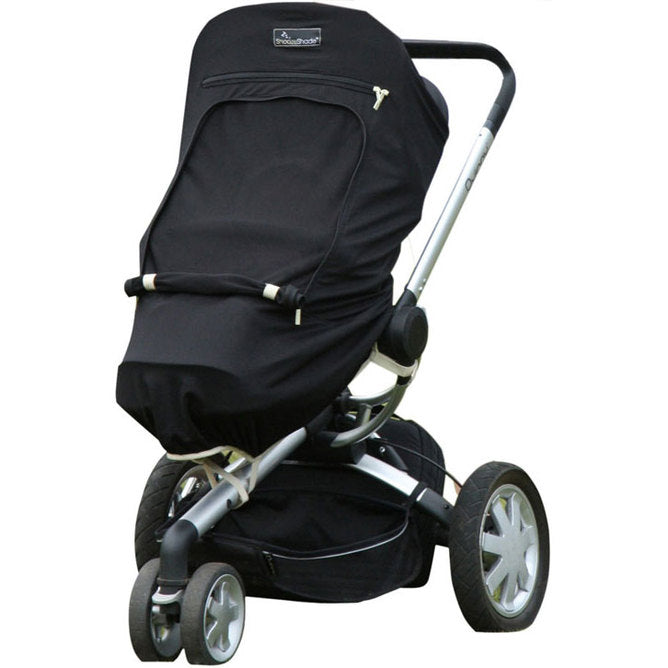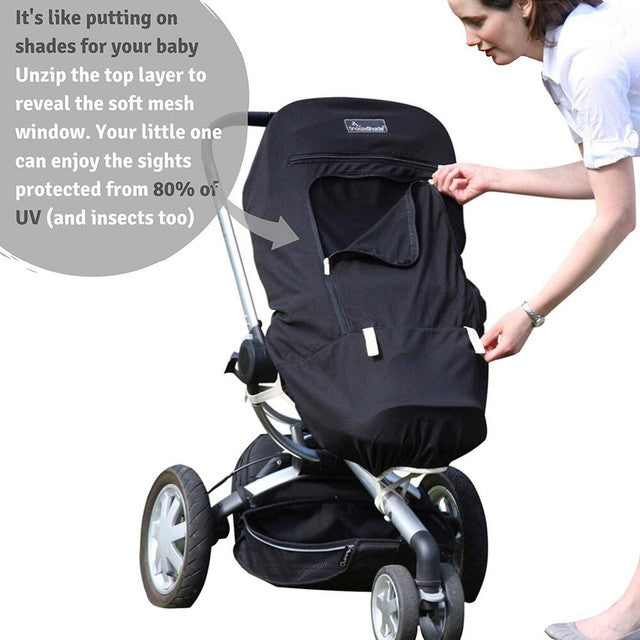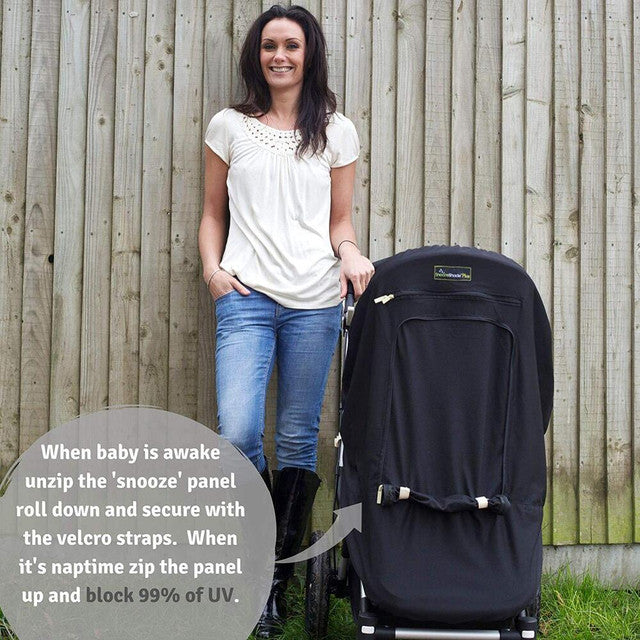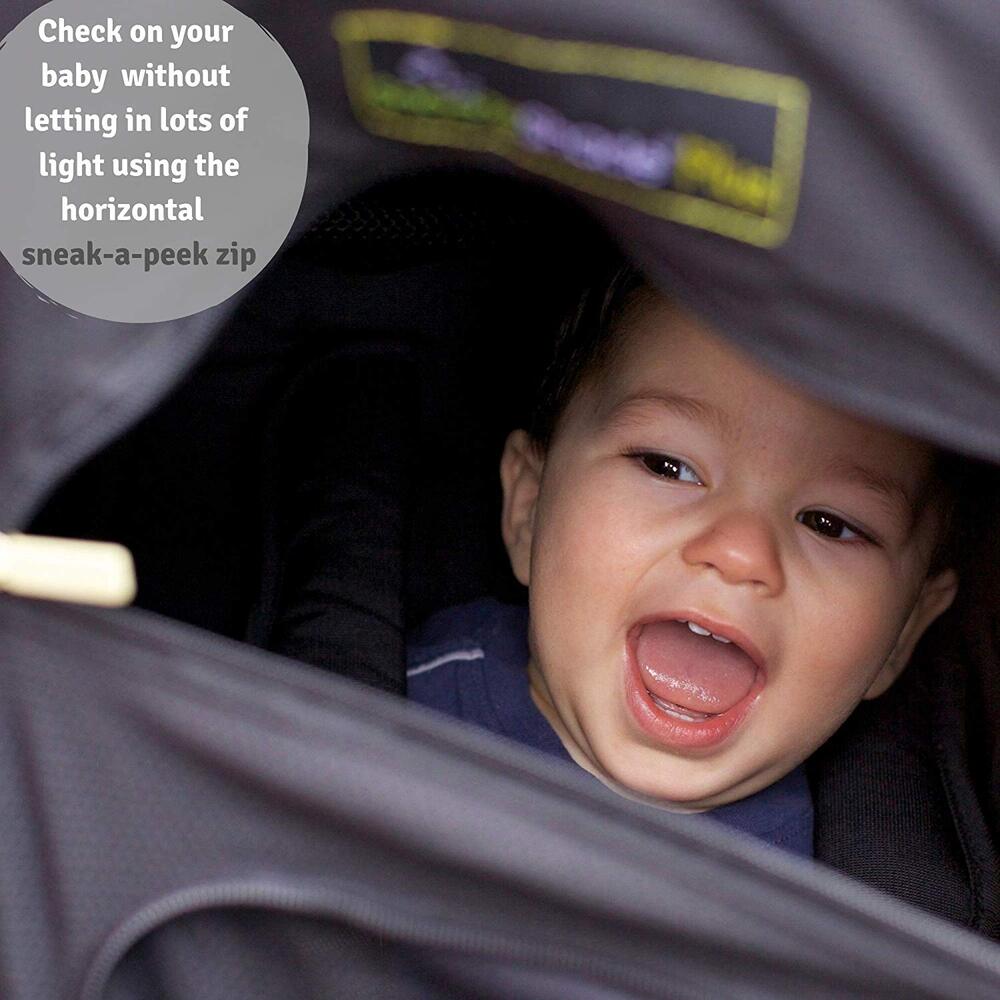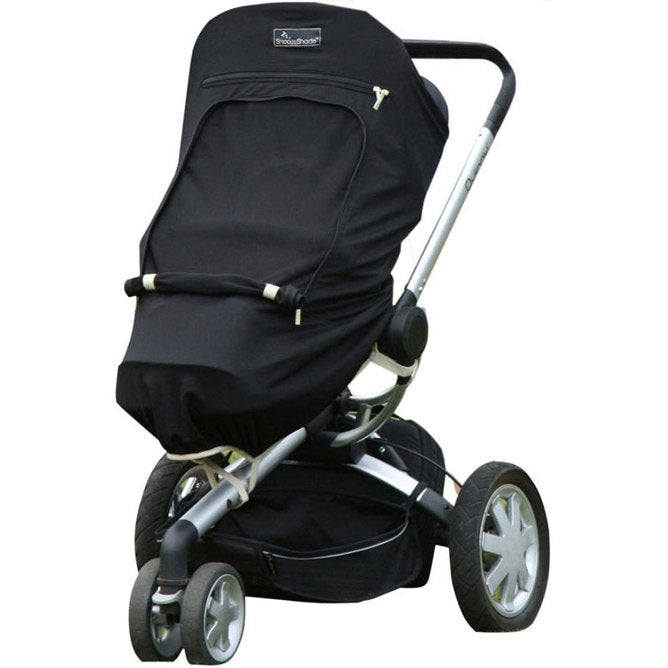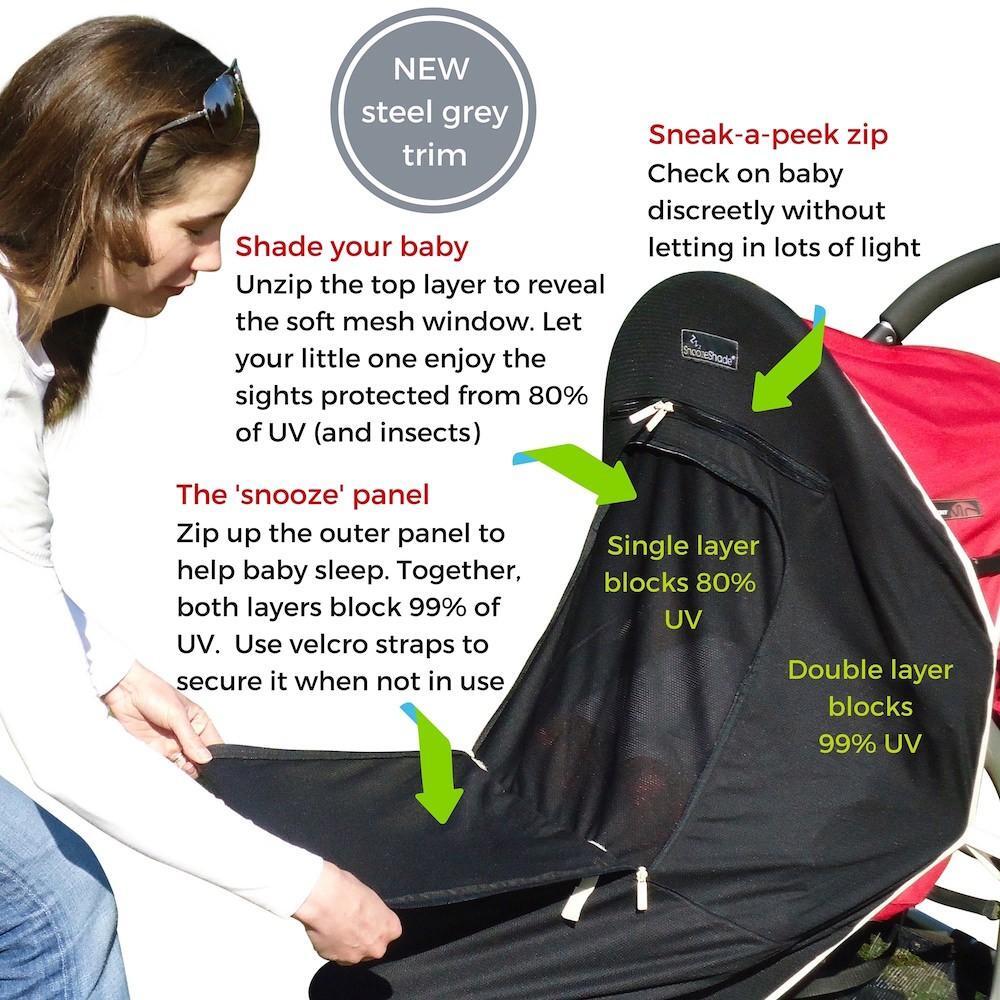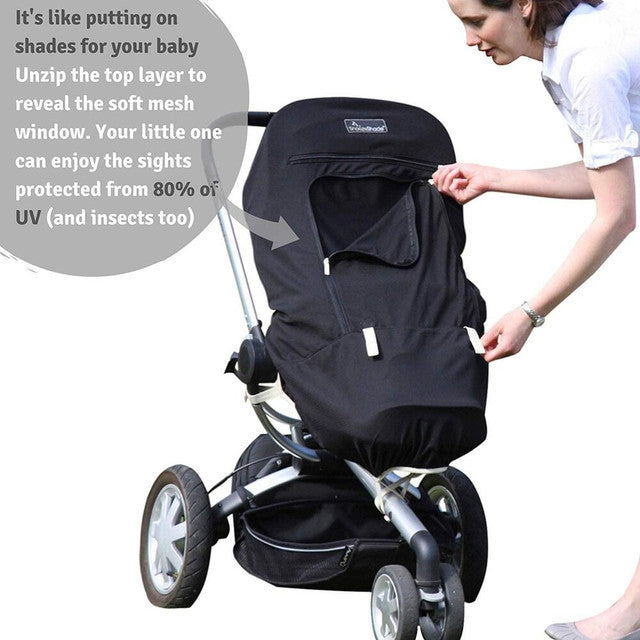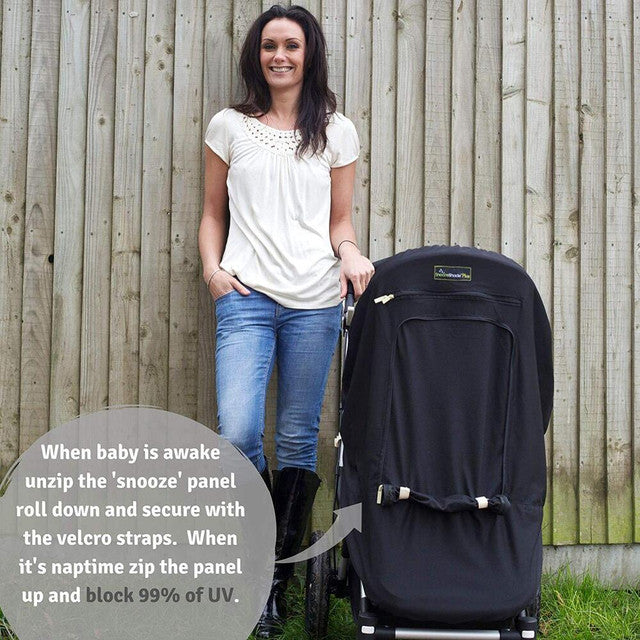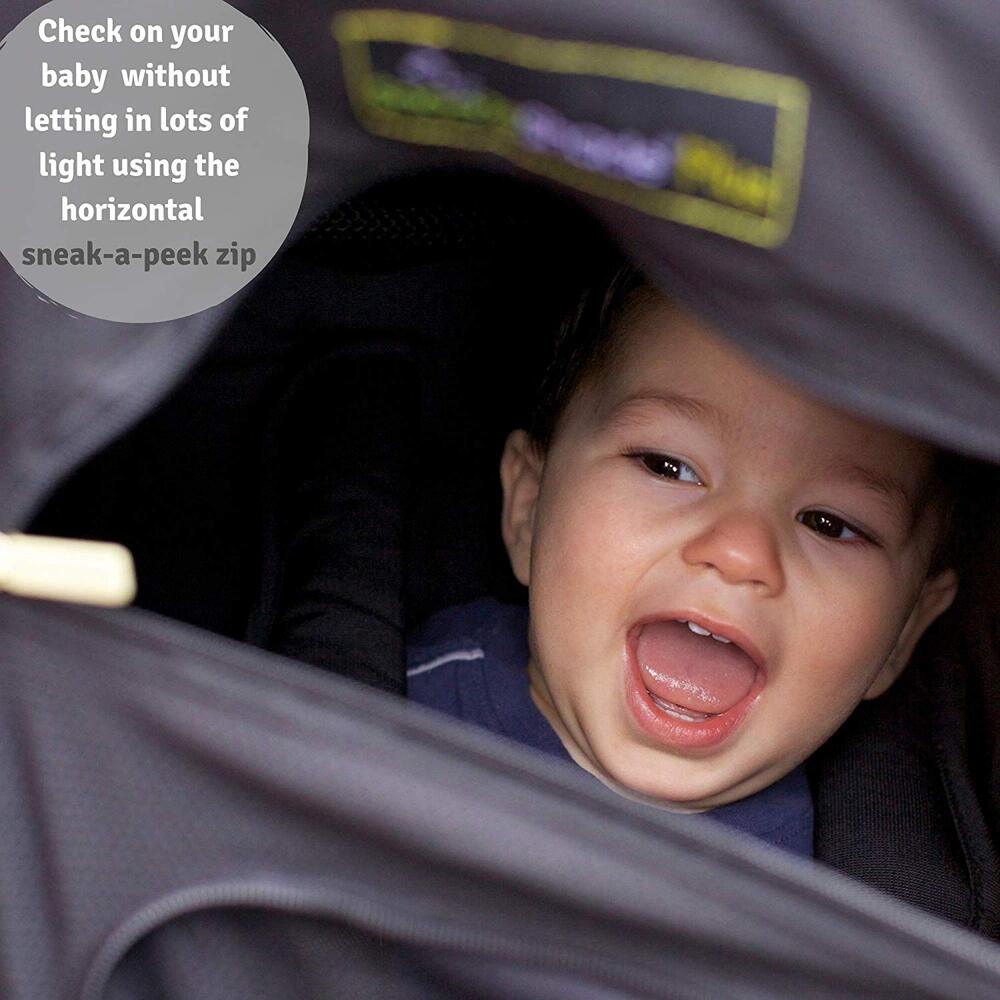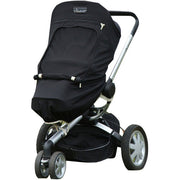Buggy Black Out Shade Cover Stage 2
Buggy Black Out Shade Cover Stage 2
SKU:SS000W102
Low stock
Couldn't load pickup availability
Overview
Overview
Designed by a mum, SnoozeShade Plus protects your baby from the sun and doubles as an on-the-go blackout blind to allow your baby to sleep wherever and whenever.
Sensational protection from sun, insects, wind, light rain, cold
Ideal for when you are out and about, whether in warmer climes or having winter adventures When the outer 'snooze' panel is fully closed 99% of UV rays are blocked, as well as protecting from light rain, chill, wind and insects.
To protect delicate young skin from the sun, 80% of UV is filtered by the large, soft, mesh window when in 'lookout' mode, while still allowing your little one to see the world go by.
Perfect for peaceful nap times.
Works as a sleep aid to block light and blur distractions that keep your baby awake. Simply zip up the outer front panel to create a dark, comfortable cocoon, making it easier for your baby to drop off to sleep at nap time.
Say goodbye to muslins and coats draped precariously over the buggy. The SnoozeShade Plus is a perfect fit on any pram or pushchair with a hood or canopy and creates the perfect environment for your baby to sleep¦ in shops, cafes, at the beach, the park, and even friends or relatives homes.
The clever sneak-a-peek zip at the top allows you to quietly check on your sleeping baby without disturbing them, too. Genius!
What's Included
What's Included
Technical Specification
Technical Specification
Delivery and Returns
Delivery and Returns
- Delivery: Free within NZ on orders over $100 (excluding bulky items) or $8 standard shipping
- Returns: Accepted within 14 days of receipt with proof of purchase
- Some items are excluded from returns including sale items, hardware, car seats, prams, monitors and personal items - please click here for the full list.
Share this product
Recently Viewed Products
Related Blogs
Top Ten Tips for a Successful Naptime
Naps are more challenging than night sleep but can be done. Napping is incredibly important, not just for your baby’s wellbeing, but for yours too. When naps are too short, erratic or unpredictable, it can be frustrating, worrying and exhausting. If you’re struggling to get your baby or toddler to nap, these ten tips could help. 1. Look out for sleep cues Ideally, your baby will be ready for sleep, but not overtired which can make napping harder. Keep an eye out for signals like frowning, jerky movements, scratching their ears or head, or making grunting noises. Toddlers may get sillier, louder, or easier to upset. 2. Skipping a nap won’t make for better sleep later Don’t skip a nap with the hope that your baby will have a better sleep later. Missing a nap will lead to overtiredness, making napping even harder. If your child has skipped a nap, they might need to go to bed earlier to make up for it. 3. It’s ok to try later If your baby is point-blank refusing to nap, it’s ok to take a break. Try pausing, and doing something else with them. If you’re following a sleep-training technique or trying to break a sleep habit, it’s ok to revert to what you know will work – you can try again when your baby is no longer overtired. 4. Avoid device screens TV, computers and other devices with screens emit blue light, which can disrupt melatonin production – the hormone that makes people feel sleepy. Watching TV up to 90 minutes pre-nap can lead to less nap time, or missing sleep altogether. This can add up to a sleep deficit, which can make the problem worse. Keep screen time to a minimum and after nap time only. 5. Develop a schedule You need to find a balance between naps and feeding, so your baby isn’t waking up because of hunger. To maximise sleep it’s also important that there is enough (but not too much!) time between sleeps. For many parents, a schedule makes this easier. Every child is different, but this sleep and feeding schedule will help give you an idea of what could work. 6. Have a pre-nap routine Bedtime routines are important – and naps need them too. Create a short pre-nap process that is a pared-back version of what you do at night. It should be cosy and relaxing, preparing your child for her nap. 7. Keep the light low and encourage quietness Your baby will find it easier to fall asleep and stay that way in a cool, dark, quiet room. To create this ideal sleep environment, check the room isn’t too hot – between 18 and 21 degrees Celsius is ideal. Hang blackout drapes, and use white noise to block out sudden noises. 8. Consistency is key Aim for at least one nap at home during the day – ideally the first of the day. If you’re out and about, the naps aren’t as restful as ones at home, which will lead to your baby becoming overtired. 9. If your baby stops napping, don’t panic Your baby can stop napping for many reasons – illness, teething, a sleep regression, a growth spurt, a developmental leap, or a change in napping schedule. During sleep regressions, your baby or toddler will change their sleeping patterns for the worse. This is exhausting and stressful, but it’s normal. This regressions generally align with big developmental leaps, around 4 months, 8 months, 11 months, 18 months, and 2 years. Nap transitions are when a child’s sleep needs change. Commonly newborns will nap 4-5 times a day, which drops to 4 at about four months old. Then, from 5-8 months, they’ll have around three naps and start resisting the fourth. From 9-18 months this will reduce to two naps a day, and you can expect your child to continue having one (ever shorter!) nap a day until they're about 3. 10. Be kind to yourself Naps are notoriously tricky to manage – your baby won’t have the same sleep pressure during the day as they have at night, so even small things can throw you off course. Like everything else involving babies, be patient with yourself and them. What’s ‘normal’ won’t work for everyone, so give yourself permission to have a bit of trial and error, and allow gentle deviations from the routine when required. Persistence, flexibility and support Naptime doesn’t have to be a struggle. Keep an eye out for sleep regression or nap transitions, and adjust schedules accordingly. Keep persisting, ask your friends and family for help and support, and pay attention to your baby’s natural tendencies. Before long, nap time will be something to look forward to!
Learn moreToys for age, stage and type
Finding the Right Toys for Your Baby’s Stage What might look like messy play or mindless rattling is actually serious business for your baby. From day one, they’re learning through movement, touch, sound, and – yes – smearing food on every available surface. Play is how your little one makes sense of the world, so choosing toys that match their stage of development can really help them thrive. Here’s a simple guide to what kinds of toys to look out for during each phase of your baby’s exciting journey. 0–6 Months: The First Explorer Your newborn may be tiny and still figuring out the basics, but their brain is already hard at work. Even in the early days, babies can recognise voices and slowly begin to track faces (though not quite in focus at first). At this stage, look for toys with high-contrast patterns and simple shapes – a mobile over the cot is ideal for visual stimulation and encouraging early motor skills as they start to reach out. A fun activity gym is amazing for development and early hand eye coordination as well. Suckling is another important reflex to support, so having safe teething toys can help build strength in their mouth muscles – which later supports chewing and speech. We stock a super fun range of teething toys at Dimples. Babies also love the sound of your voice, so don’t hesitate to chat away, sing, or start reading aloud. Soft crinkly activity books are a great addition as they are very visually interesting to your little one, as well as a high contrast board book. 6–12 Months: The Little Scientist As your baby gets stronger, tummy time becomes key for building neck and upper body strength. Use an engaging play mat to make tummy time fun and motivating. Around six months, proper teething often begins, so toys they can safely chew are your best friends – easing discomfort while supporting oral development. At this stage, babies are all about discovery – they’re working on sitting up, crawling, grasping, and even pulling themselves to stand. Toys that support these physical leaps are ideal. Look for soft balls to encourage rolling and crawling, stacking toys for building early coordination, and activity cubes or busy boards with things to twist, slide, and push. Toys that respond with sound or light when touched can also be hugely exciting (and educational), helping babies connect cause and effect. And don’t forget the classics – things that crinkle, rattle, or squeak are still crowd-pleasers and support sensory development beautifully. 12–18 Months: The Creative Genius You’ve made it through the first year – what a milestone! At this age, many little ones are eager to master walking. A sturdy walker toy can support their balance and leg strength as they wobble around with pride. Fine motor skills also start taking centre stage. Now that your little one is on the move and growing more curious by the day, toys that support exploration, movement, and problem-solving are ideal. Push-and-pull toys like the classic Buzzy Bee or this cute crocodile pull along are perfect for developing balance and coordination as they become more confident on their feet. Large building blocks or stacking rings help improve fine motor skills and spatial awareness. This is also a great age for toys that encourage interest in pretend play – think toy phones, baby dolls, animal figurines, or mini tea sets. Musical instruments like tambourines, shakers, or xylophones are not only fun but also help with rhythm and sensory processing. Chunky crayons are also great for encouraging early scribbles – and those early masterpieces might earn a spot on your fridge. As their vocabulary starts to form and their understanding of language grows, this is the perfect time to keep those conversations flowing. Reading together, singing songs, and chatting about what you’re doing throughout the day helps build their language skills and connection to you. Even if they’re not saying much just yet, they’re absorbing it all – storing up words, rhythms, and tones to use later. 18–24 Months: The Big Personality Welcome to toddlerhood – where the big personality really comes through! At this stage, your child is becoming more independent, showing clear preferences, and beginning to express their likes and dislikes. You might notice them choosing to play solo more often, or forming strong attachments to certain toys, books, routines, or even characters from stories and shows. This is also when pretend play really starts to blossom. Role-playing everyday scenarios – like cooking dinner, feeding a doll, or making a pretend phone call – is not only adorable, it’s an important part of social and emotional development. A toddler-sized kitchen set is a fantastic toy at this age, encouraging imaginative storytelling and helping little ones mimic the world they see around them. One of these Kitchen Helpers let your toddler safely join you at the counter, fostering independence and fine motor skills. By involving them in simple kitchen tasks, you’re nurturing their creativity and boosting their confidence in a hands-on way. Beginner puzzles are also a great choice to foster problem solving skills – Particularly ones with familiar objects such as this zoo puzzle, or this vehicle puzzle. At this age, play becomes more purposeful – every stack, stir, and story is helping your little one make sense of the world and build skills for the future. Go at Their Pace Every baby develops at their own rhythm. Some skip crawling and go straight to walking. Others might take their time with speech while still communicating effectively in their own way. It’s tempting to compare, but there’s a wide range of normal. If you’re ever concerned, have a chat with your GP or child health nurse. Most importantly, be kind to yourself. You're doing an incredible job raising a one-of-a-kind little person. And remember – the best toy of all is you. Your love, voice, and presence are what your baby cherishes most ❤️
Learn morePostnatal Pelvic Floor Health: A Physiotherapist’s Guide
Bringing a new baby into the world is an incredible journey, but one that places big demands on your body - especially your pelvic floor.
Learn moreYour Guide to Antenatal Classes
At Dimples, we understand that preparing for the arrival of your little one can feel both exciting and overwhelming. That’s why we’ve teamed up with Grace Strange – Midwife and owner/founder of Antenatal Co.
Learn more

